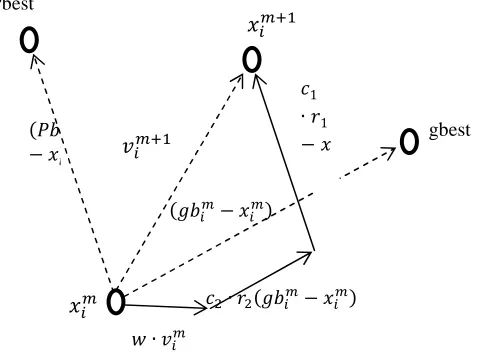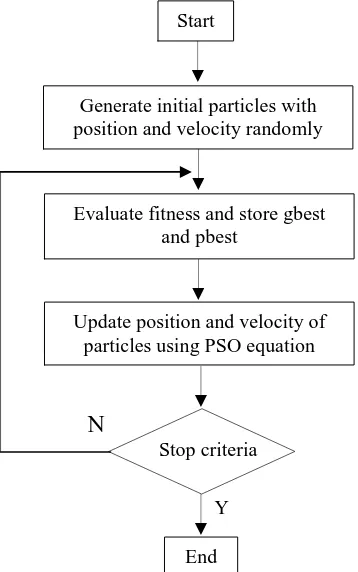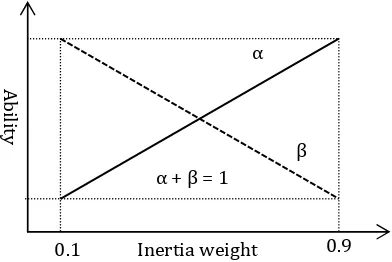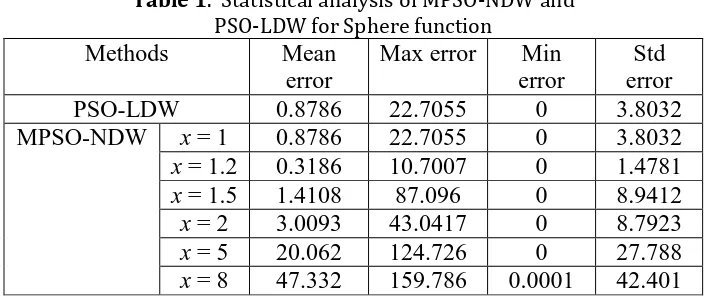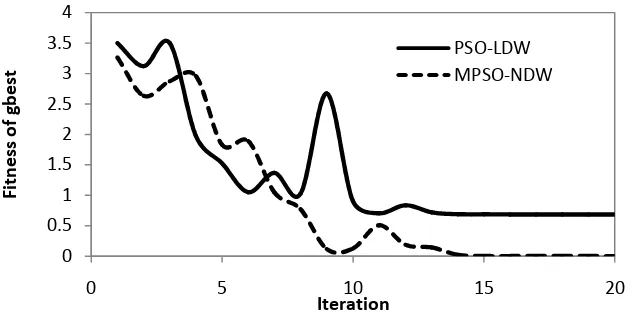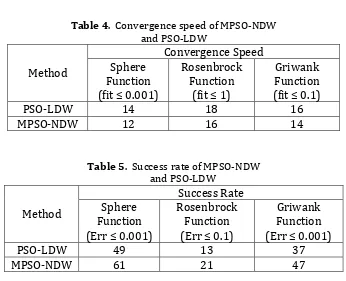Modified Particle Swarm Optimization using
Nonlinear Decreased Inertia Weight
Alrijadjis1, Shenglin Mu2, Shota Nakashima3, Kanya Tanaka4
1)Politeknik Elektronika Negeri Surabaya, 2)Hiroshima National College of Maritime Technology, 3),4)Yamaguchi University
1)Jl. Raya ITS, Keputih, Sukolilo, Surabaya, Indonesia, Telp. +62(31)5947280, 2) 4272-1 Higashino, Osakikamijima, Toyota District, Hiroshima 725-0234272-1, Japan, Telp. +84272-1-
+81-846-65-3101, 3),4)2-16-1 Tokiwadai, Ube-shi 755-8611, Japan, Telp. +81-836-85-9005
E-mail: 1)[email protected], 2) [email protected], 3) [email protected], 4) [email protected]
Abstract
Particle Swarm Optimization (PSO) has demonstrated great performance in various optimization problems. However, PSO has weaknesses, namely premature convergence and easy to get stuck or fall into local optima for complex multimodal problems. One of the causes of these weaknesses is unbalance between exploration and exploitation ability in PSO. This paper proposes a Modified Particle Swarm Optimization (MPSO) using nonlinearly decreased inertia weight called MPSO-NDW to improve the balance. The key idea of the proposed method is to control the period and decreasing rate of exploration-exploitation ability. The investigation with three famous benchmark functions shows that the accuracy, success rate, and convergence speed of the proposed MPSO-NDW is better than the common used PSO with linearly decreased inertia weight or called PSO-LDW
Keywords: particle swarm optimization (PSO), premature convergence, local optima, exploration ability, exploitation ability.
1. INTRODUCTION
Particle Swarm Optimization (PSO) is one of the evolutionary computational technique developed by Kennedy and Eberhart in 1995 [1]. It is a population-based stochastic search algorithm inspired by the simulation of the behavior of the birds flocking or fish schooling. The basic idea of PSO comes from the research of the behavior for the bird swarm to catch food. PSO has shown good performance in finding good solution to optimization problems, and turned out to be another powerful tool besides other evolutionary algorithm such as Genetic Algorithm (GA) [2], [3]. Compared with genetic algorithm and ant algorithm, PSO has simple algorithm or form, faster convergence, efficient in time-calculation and is easily implemented as well as the adjustable parameters are few, so PSO is adept to solving many non-derivative and multi-peak complex optimization problems. PSO has been successfully applied to many science and practical fields [4]-[7].
Although PSO has superior features, it has some problems, such as premature convergence and fall into local optima [2], [8]. It was reported that the causes of the problem are unbalance between exploration-exploitation ability and lost-diversity or lack-information due to fast rate flow in sharing information. Exploration ability or global search ability is the ability to identify a region with a best solution. Particles with strong exploration ability have a high speed velocity to search in a wider area. Exploitation ability or local search ability is the ability to find a best solution in a targeted area or limited area. Particles with strong exploitation ability have low speed velocity to refine and capture a best solution. If the particles are far from a best solution, strong exploration ability is better. If the particles are close to a best solution, strong exploitation ability is better. Due to random process and particle’s movement, the position of particles is always changed in each iteration. So, the control of both abilities in order to get a proper balance is needed. In previous method called PSO using linearly decreased inertia weight (PSO-LDW) [9], inertia weight adjustment was used to control these abilities. In the first iteration, inertia weight is set in maximum value, and then it is linearly decreased until minimum value at the end iteration. Although, PSO-LDW is better than PSO using constant inertia weight, sometimes it suffers from the problem of being trapped in local optima and premature convergence.
In this paper, the PSO-LDW is revised with a nonlinearly decreased inertia weight, proposed to efficiently control the period and decreasing rate of exploration-exploitation ability. A new parameter called nonlinear index number is added to control the path of inertia weight. The proposed MPSO-NDW was verified on three benchmark functions and the results were compared with the original PSO-LDW.
original PSO, and the simulation result is analysed. Finally, section 5 concludes with a summary.
2. PARTICLE SWARM OPTIMIZATION ALGORITHM
PSO is a population-based optimization method using the concept of cooperation inspired by the behavior of organism, such as birds flocking or fish schooling, in search for food [1]. The outline for PSO is marked as follows. Let consider the optimization problem of maximizing the evaluation function f : M→M'⊂R for variable x∈M⊂Rn . Let there be N particles (mass
point) on M dimensional space, where the position vector and velocity vector of i(= 1,2,3,....,N)th particle for m searching number are and . The best position for each particle in the evaluation function f(x) of searching point is represented as Pbi (Pbest), while the best position of f(x) in the searching
point for the whole particle is represented as gb (gbest). The particles are manipulated according to the following recurrence equations:
= ∙ + ∙ ∙ − + ∙ ∙ − (1)
= + (2)
= − − ∙ (3)
wherew is the inertia weight; c1 and c2 are cognitive and social constant; r1
and r2 are random numbers. There are three parts or vectors that affect the
particle’s movement, i.e., momentum vector, (w.v), cognitive vector, (Pb – x), and social vector, (gb –x). According to Eq. (1) and Eq. (2), the particle’s movement in PSO can be illustrated in Fig. 1. The next position of particle is the resultant of three vectors.
Figure 1. Particle’s movement in PSO
The working mechanism of PSO algorithm can be described in four steps as follows:
∙
−
∙ −
gbest
−
Pbest
1
∙ 1
1. Deploy a population of candidate solution (or particles) in the searching-area randomly. Each particle can handle a candidate solution with D-dimension.
2. Evaluate the fitness value of each particle and set as pbest and gbest. 3. Update the position and velocity of each particle using Eq. 1 and Eq. 2. 4. Check the termination condition. If the condition is not met, return to
No. 2. If the condition is met, the process is complete and the optimal solution is the particle with gbest.
The flowchart of the PSO algorithm is shown in Fig. 2.
Figure 2. The flowchart of PSO
3. PROPOSED MODIFIED PSO
The most important parameter of PSO is inertia weight because of its capability to control the balance of exploration-exploitation abilities. Recently, research to improve PSO is being conducted intensively. Improving PSO is focused on how to adjust inertia weight in order to get a proper balance. The relationship between inertia weight and ability in PSO is shown in Fig. 3. The range of inertia weight is from 0.1 to 0.9. The lower inertia weight will cause strong exploitation ability (β) and weak exploration ability (α). The higher inertia weight will cause weak exploitation ability and strong
Start
Generate initial particles with position and velocity randomly
Evaluate fitness and store gbest and pbest
Update position and velocity of particles using PSO equation
Stop criteria
End Y
exploration ability. The combination of both abilities is one (α + β = 1). The problem is how to adjust inertia weight in order to get a proper combination or balance between exploration-exploitation abilities.
Figure 3. Inertia weight and abilities of PSO
Figure 4. Path of inertia weight
In the original PSO, inertia weight is linearly decreased from maximum value to minimum value as shown in Eq. 3. It is called PSO-LDW [8]. As shown in Fig. 4, due to this strategy, the usage period of exploration ability (Tα = T3 – T1) is similar with the usage period of exploitation ability (Tβ = T4 – T3), or Tα = Tβ. Also, the decreasing rate of exploration ability (∆ = ! " ) is similar with the increasing rate of exploitation ability (∆#= &' !$%), or Δα = Δβ. So, there is no controlling of the usage period and changing rate of exploration-exploitation abilities in PSO-LDW. It is a weakness of PSO-LDW.
In the proposed method, we want to investigate the impact of usage period and decreasing or increasing rate of exploration and exploitation ability. To control the period and the changing rate, the path of inertia weight must be made nonlinear using a nonlinear index number. It means that inertia weight is nonlinearly decreased from maximum value to minimum value by the following equation:
w = + − ∙ ) * (4)
wma
T1 wc
wmin
T2 T3 T4
PSO-LDW MPSO-NDW α
β α + β = 1
Inertia weight
A
b
ili
ty
wherex is nonlinear index number. Higher of x will cause the usage period of exploration ability is shorter than the usage period of exploitation ability, Tα< Tβ, and the decreasing rate of exploration ability is faster than the increasing rate of exploitation ability, Δα>
4. EXPERIMENTAL RESULTS
This section compares the performance of the proposed MPSO-NDW with the original or common PSO-LDW discussed in Section 2. To verify and evaluate the efficiency and the effectiveness of the proposed approach we have used three widely known benchmark functions with different characteristics, i.e., Sphere function (with single optimum solution), Rosenbrock’s function (with one local optimum and one global optimum) and Griwank’s function (with one global optimum and many local optimums), as follows:
+ , - = − 15 + - − 20 (5)
+ , - = 10 ∙ − - + 1 − (6)
+1 , - = 1 +
2 32
45 − cos ∙ :; )√3* (7)
The global best solution for the Sphere function is zero which is achieved when x = 15 and y = 20; for the Rosenbrock’s function is zero which is achieved when x = 1 and y = 1; and for the Griwangk’s function is zero which is achieved when x = 0 and y = 0.
For the purpose of comparison, all the simulation deploy the same parameter settings in both of PSO (original PSO-LDW and MPSO-NDW) such as the maximum number of iterations, itermax = 20; cognitive constant, c1 =
1.0; social constant, c2 = 1.0; number of particles, N = 5, maximum inertia
weight, wmax = 0.9; and minimum inertia weight, wmin = 0.1. Since PSO is a
stochastic algorithm that randomly searches the best solution, so for testing we have done as much as 100 runs.
Table 1. Statistical analysis of MPSO-NDW and
Table 2. Statistical analysis of MPSO-NDW and PSO-LDW for Rosenbrock function
Figure 5. Convergence speed of MPSO-NDW and PSO-LDW for Sphere function
Figure 6. Convergence speed of MPSO-NDW and PSO-LDW forRosenbrock function
Table 4. Convergence speed of MPSO-NDW
The comparison of convergence speed between MNDW and PSO-LDW for Sphere function, Rosenbrock function and Griwank function are shown in Fig. 5, Fig.6, and Fig.7, respectively. It is easy to see that the convergence speed of MPSO-NDW is faster than that of PSO-LDW. Also, Table 4 shows convergence speed averaged over 100 runs in obtaining the predetermined fitness value. In here, the predetermined fitness value for Sphere function, Rosenbrock function and Griwank are 0.001, 1 and 0.1, respectively. To achieve these values, PSO-LDW needed 14, 18, and 16 iterations. While iterations required by MPSO-NDW to achieve these values are 12, 16 and 14, respectively.
Success rate represents the success of method in obtaining a predetermined minimum error within all runs. Table 5 shows the success rate of MPSO-NDW and PSO-LDW within 100 runs for each function. The predetermined minimum error for Sphere function, Rosenbrock function and Griwank function are 0.001, 0.1, and 0.001, respectively. In general, the success rate of MPSO-NDW is higher than PSO-LDW for all benchmark function.
5. CONCLUSIONS
inertia weight. The main contribution of this paper is to show that the nonlinear path of inertia weight can affect the performance of PSO. The second contribution is to give us new ideas for analysis PSO using controlling the usage period of exploration-exploitation abilities in PSO.The proposed MPSO-NDW was applied to three well known benchmark function and compared with the common PSO-LDW. Experimental results indicate that a proper controlling of the period and decreasing rate can increase the performance of PSO in term of accuracy, success rate and convergence speed.
REFERENCES
[1] J. Kennedy, R.C. Eberhart, Particle Swarm Optimization, Proceeding IEEE International Conference on Neural Networks, pp. 1942-1945, 1995 [2] Y. Shi, R.C. Eberhart, A modified particle swarm optimizer, Proceeding
of IEEE International Conference on Evolutionary Computation, Anchorage, Alaska, pp. 69-73, 1998
[3] J. Kennedy, R.C. Eberhart, Y. Shi, Swarm Intelligence, San Fransisco: Morgan Kaufman Pubhisher, 2001
[4] A. Chander, A. Chatterjee, P. Siarry, A new social and momentum component adaptive PSO algorithm for image segmentation, Expert System with application, No. 38, pp. 4998-5004, 2011
[5] C.L. Chen, R.M. Jan, T.Y. Lee, C.H. Chen, A novel particle swarm optimization algorithm solution of economic dispatch with valve point loading, Journal of Marine Science and Technology, Vol. 19, No. 1, pp. 43-51, 2011
[6] H. Zhu, C. Zheng, X. Hu, X. Li, Adaptive PSO using random inertia weight and its application in UAV path planning, Proceeding of SPIE, Vol. 7128, pp. 1-5, 2008
[7] K. Tanaka, Y. Murata, Y. Nishimura, Faridah A. Rahman, M. Oka, A. Uchibori. Variable gain type-PID control using PSO for ultrasonic motor. Journal of the Japan Society of Applied Electromagnetics and Mechanics, Vol. 18, No. 3, 118-123, 2011
[8] I.C. Trelea, The particle swarm optimization algorithm: convergence analysis and parameters setting, Information Processing Letters, No. 85, pp. 317-325, 2003
